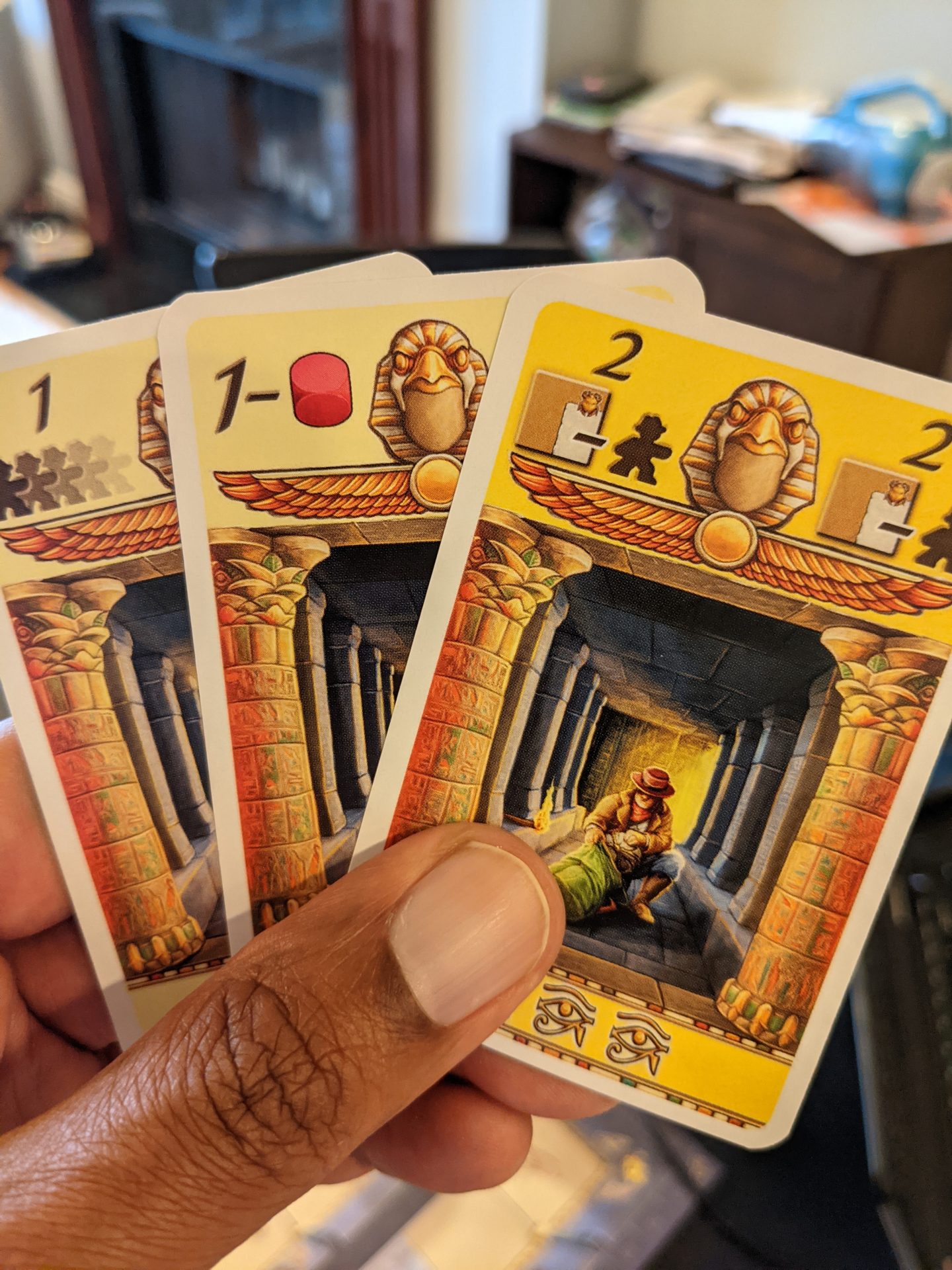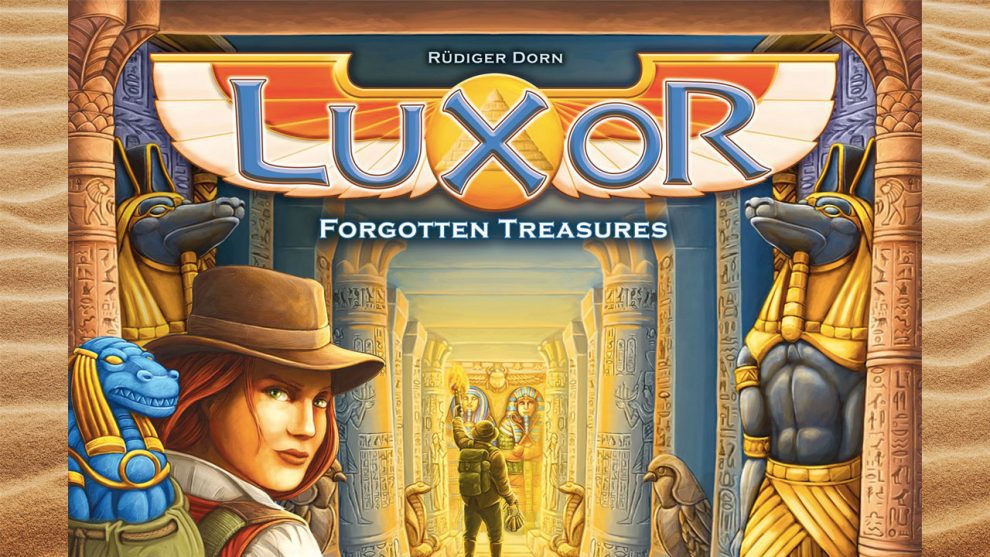“Those are all the rules? Hmm, I was afraid this was going to be hard to learn!”
I had just finished a teach of the game Luxor with my dad and stepmom, and as I was unpacking the box and setting up the game, I kept looking at the two of them to ensure they weren’t already overwhelmed by these “newfangled” board games.
But they kept an open mind and a blank stare on me during the teach, which only took about 10 minutes. At the end of it, my dad uttered that line above. Then I looked at my stepmom.
“Let’s go!” she said. “I like this theme already.”
And here’s what I love most about this memory: every time I teach this game, people have the same reaction to Luxor. Simple rules, quick turns, a very clear endgame condition, my favorite hand management mechanism of all time and a theme that reminds everyone of the Indiana Jones movies.
For all of these reasons and more, I love putting Luxor on the table. Let’s talk about why it will never leave my collection!

Raiders of the Lost Ark, with Cards!
Luxor was nominated for the prestigious Spiel des Jahres award in 2018, and with good reason: it’s a very accessible game for players of all shades and it works as a heavy filler or even a family game.
In Luxor, players assume the role of a group of adventurers as they plunder the legendary temple at Luxor. The goal of the game is to score the most points by moving your pool of 5 adventurer meeples around the board. All players start with 2 active meeples but by moving deeper into the tomb, players will unlock as many as 3 more meeples which will magically appear at the tomb entrance to be moved inside.
The game board is a twisting tunnel of spaces that run from the start of the temple into the sarcophagus chamber. Spaces begin the game occupied with tiles of varying types: treasure (set collection items worth end-game points), “Osiris” tiles used to boost movement, and “Horus” tiles, which allow a player to grab a key used for entry into the sarcophagus chamber or access to better cards. Over the course of gameplay, some treasure tile spaces will morph into something else: wild cards used for the set collection mini-game, Scarabs (secret end-game points), tunnels, or other game effects.
It’s the movement of your adventurer pool that is the heart of what makes Luxor sing. All players have a hand of five cards. These cards usually have a number on them ranging from 1-5, which indicates the number of spaces any one meeple you select can move forward (or occasionally, backwards) into the tomb. On your turn, you can only select the outermost left or right card in your hand to play, using that movement number to move a single active meeple forward a number of spaces, using only active tiles to count that number.
Then, based on where that meeple lands, something will happen:
- If you land on a treasure, and you have the number of meeples of your own color now on this tile to match the number of adventurer icons, you score it and capture that tile to add to your end-game set collection.
- If you land on an Osiris tile, keep moving forward then do whatever action is on the next tile.
- If you land on a Horus tile, you can take a key or a better card. If you take the card, this replaces the “Draw a card” action at the end of your turn.
- And if you land on one of the Temple tiles, do its required action.
Unless you took a card through the Horus action, you’ll then take one card from the draw pile and place it exactly in the middle of your hand of 4 other cards, giving you a new 5-card hand for the next round.
The game finish of Luxor is built on a timer; whenever a second meeple is moved into the sarcophagus chamber, that current round finishes and a winner is declared.
Points are scored in a variety of different ways—the sarcophagi give you points, your set collection treasures give you points, and each of your Scarabs give you points too. Plus, you’ll get points based on the space where each of your adventurers are when the game ends, so jockeying for positioning at the end is really important.

So Slick!
I knew I loved this game when I sat down at the Queen Games booth at Gen Con back in 2018 and did a demo of Luxor. The rep gave us a teach for a 4-player game, and we played an entire game in 25 minutes.
TWENTY-FIVE MINUTES!!!
Now, we didn’t have the nuances down of what you’ll see in games with many of the pros I’ve dueled against in the Luxor version on Board Game Arena, where one person speeds an adventurer to the finish line then gets all of their other meeples closer to the sarcophagus chamber while slowing gathering all of the treasure and Scarabs that they can.
But still! You can play Luxor any way you want, and speeding to the finish is one way to both score a good number of points and ensure that other players don’t have the chance to collect a lot of treasure or activate all of their adventurers. And that’s another reason why I love Luxor: there are a few different paths to victory.
And the gameplay is so smooth, thanks to the hand management mechanic. You literally only have the choice of 2 cards to play each turn, and when you slot your new card into your hand, you’ll have a moment to plan out your next move. Sometimes, you have the exact same card on both sides of your hand, but you are trying to set up a future move, making it easier to choose which card you want to get out of the way first.
Thanks to all of this, turns in Luxor sometimes take 10-15 seconds. Even when I played this for the first time with my family, the game took just over an hour; usually, my wife and I can play an entire 2-player game in 20 minutes.

Why Do I Love Luxor?
Luxor is the Swiss army knife of my collection. It’s a great beach game. It’s a great family game. It’s a great long filler, the kind of game where someone tells you they are “running a little late” for game night but you know they are usually 30-40 minutes late to everything. It works with gamers new to the hobby. It’s got enough depth to work as a game for those who are really invested in the hobby.
It works with 2, 3 and 4 players equally well. There’s enough variability with tile placement at setup that no two games play out the same way. The Horus cards are better than the initial draw deck, which changes your strategy as the game goes along.
And, in a game about raiding tombs, you can play the incredible “Raiders of the Lost Ark” music while you go through the game…and usually, the John Williams score lasts just as long as the playtime. It just adds so much atmosphere!!!
Luxor was designed by Rudiger Dorn, who also designed another of my favorites, Istanbul. I’m told that two other games he designed are classics, Goa and Las Vegas, so I need to try those out to dive deeper into Dorn’s design philosophy.
Luxor is the go-to in my collection for almost any audience. It’s as close to the perfect game as I have ever played. It’s not the lightest, or the deepest, or the best production quality, or the party game of choice. It just fits!












Add Comment